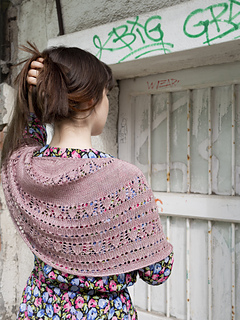patterns >  Punto y aparte Vol.2 and 2 more...
Punto y aparte Vol.2 and 2 more...
> zahora shawl












zahora shawl
ENGLISH BELOW
Un dingolondango es una carantoña, un mimo, un arrumaco, y no hay palabra que no defina mejor las lanas que Marta crea con sus manos, que te arropan con la luz y el color del sur en cuanto las ves. Ella creció entre pinceles, con el color y la alegría de la pintura de sus padres, pintores los dos, impregnando cada minuto de su vida.
Con sus lanas diseñé este chal, al que ella ha puesto un nombre de origen árabe que recuerda esas playas gaditanas, en las que sus madejas se secan con la brisa del mar. Se llama ZAHORA, una preciosa palabra con un significado también muy especial. Porque dice el diccionario de la Real Academia que una zahora es una “Comilona o merienda de amigos en que hay bulla y zambra”.
Qué mejor meta pueden tener estas lanas después de tejer este chal que estrenarlo en una zahora, degustando una apetitosa comida donde se mezcle el bullicio, las risas y el buen humor de los amigos con el tacto de estas lanas, arropándonos en una noche de dingolondangos.
Gracias a la hermana de Marta, Cristina, por ayudarnos a las dos a contaros esta historia. En el momento de sacar este libro a la luz Marta estaba inmersa en un trabajo espectacular de teñido y no tenía tiempo más que de contarle la historia a Cristina, que fue quien me la contó a mí.
NOCIONES PREVIAS:
Para tejer este chal es necesario saber tejer punto del derecho, y del revés, montaje en punto del derecho para chales, remontar puntos, echar hebra y tejer puntos juntos.
CONSTRUCCIÓN:
Este chal se teje de arriba hacia abajo (top down) empezando por el borde superior, en el centro, con el montaje “garter tab” o montaje de borde en punto del derecho, y creciendo hacia los laterales y hacia abajo, su forma final es de media luna.
TALLAS:
Talla única.
AGUJAS:
Agujas circulares de 3.75 mm (US 5) con cable de 80 cm (32”), o las necesarias para obtener la muestra de tensión. Una aguja de al menos un número mayor para el cierre de puntos.
ACCESORIOS:
Aguja lanera para rematar hebras.
HILO:
1 madeja Mariseda de Dingolondangos Lanas (50 % Merino 50% Seda; 400 m / 100g; 437 yd / 3.52 oz).
MUESTRA:
22 puntos y 34 vueltas para una muestra de 10 x 10 cm (4 x 4”) en punto jersey, después de bloquear.
+++++++++++++++++++++++++++++++++++++++++++++++++++++
A dingolondango is a caress, a cuddle, a snuggle, and there is no other word that defines the yarns that Marta creates with her hands better, they surround you with the light and colour of the south as soon as you set your eyes upon them. She grew up among paint brushes, with the colour and joy of her parents’ paints, painters both of them, coating every minute of her life.
With her yarns I designed this shawl, one that she gave an Arabic name to, a name that recalls the beaches from Cadiz, where her skeins dry with the sea breeze. Its name is ZAHORA, a beautiful word with a very special meaning. As the Spanish Royal Academy dictionary defines, a zahora is a “big meal with friends where there is ruckus, rejoice and dancing”.
What a better goal this yarn could have after knitting this shawl than to wear it for the first time in a zahora, savouring a mouth-watering meal, where racket, laughter and friends’ good mood mix with the touch of these yarns, surrounding us in a night for dingolondangos.
We have Cristina, Marta’s sister, to thank for helping us tell you this story. At the moment of bringing this book to light, Marta was immersed in dyeing work and she did not have much more time than telling this story to Cristina, who in turn, told it to me.
SKILLS:
To knit this shawl, you need to know how to knit, purl, perform a garter tab cast-on, pick up stitches, yarn over, and make increases and decreases.
CONSTRUCTION:
This shawl is knit top-down, starting at the centre of the top border, with a garter tab cast-on, then growing to the sides and down, its final shape is a crescent.
SIZES:
One size.
NEEDLES:
3.75 mm (US 5) / 80 cm (32”) circular needles, or the required needle size to obtain gauge. Needles one size larger at least, for bind-off.
NOTIONS:
Tapestry needle to weave in ends.
YARN:
1 skein Meriseda from Dingolondangos Lanas (50 % Merino Wool 50% Silk; 400 m / 100g; 437 yd / 3.52 oz).
GAUGE:
22 stitches and 34 rows in 10 x 10 cm (4 x 4”) in stockinette stitch, after blocking.

33 projects
stashed
28 times
- First published: September 2019
- Page created: August 19, 2019
- Last updated: September 1, 2019 …
- visits in the last 24 hours
- visitors right now




